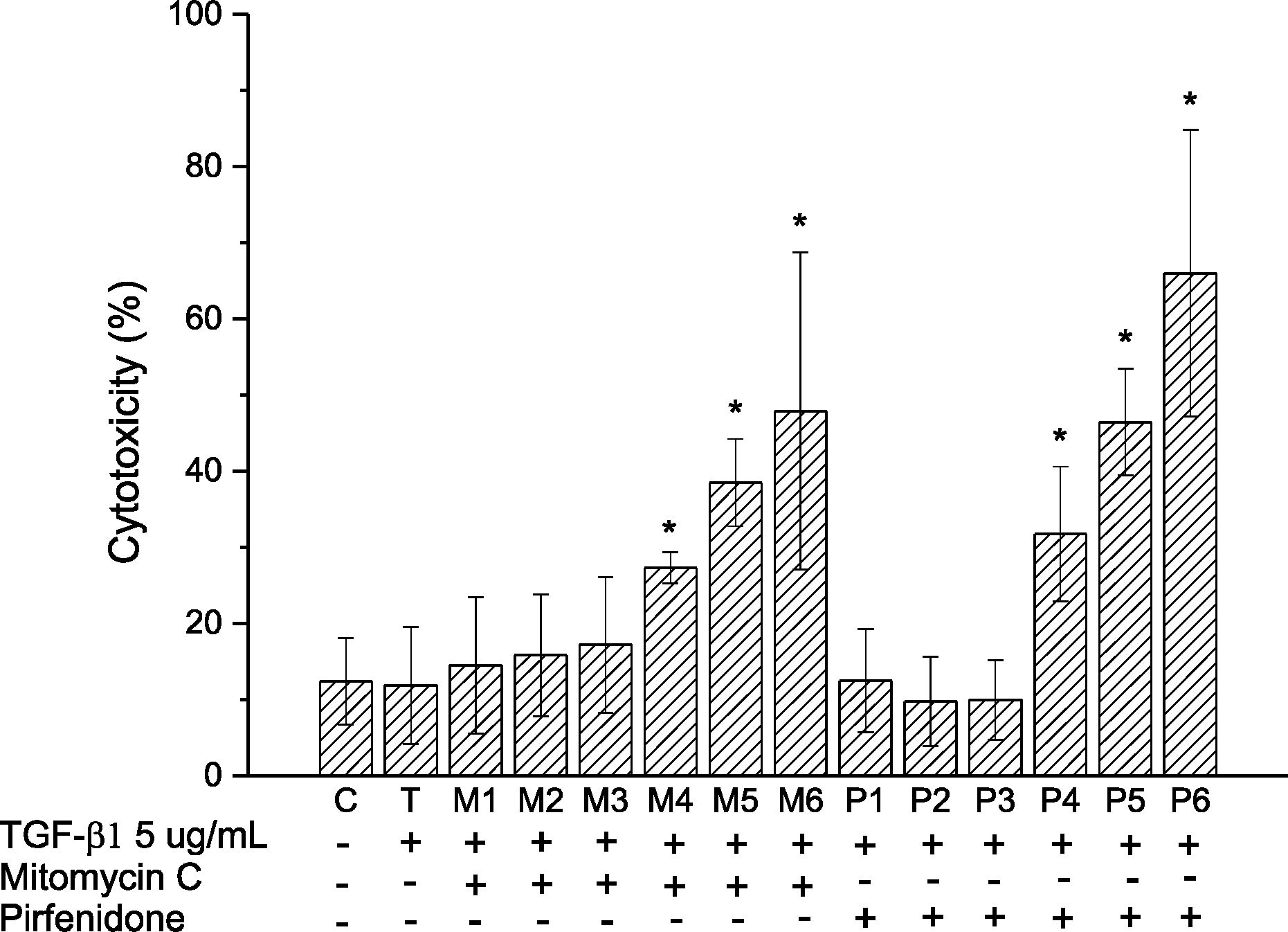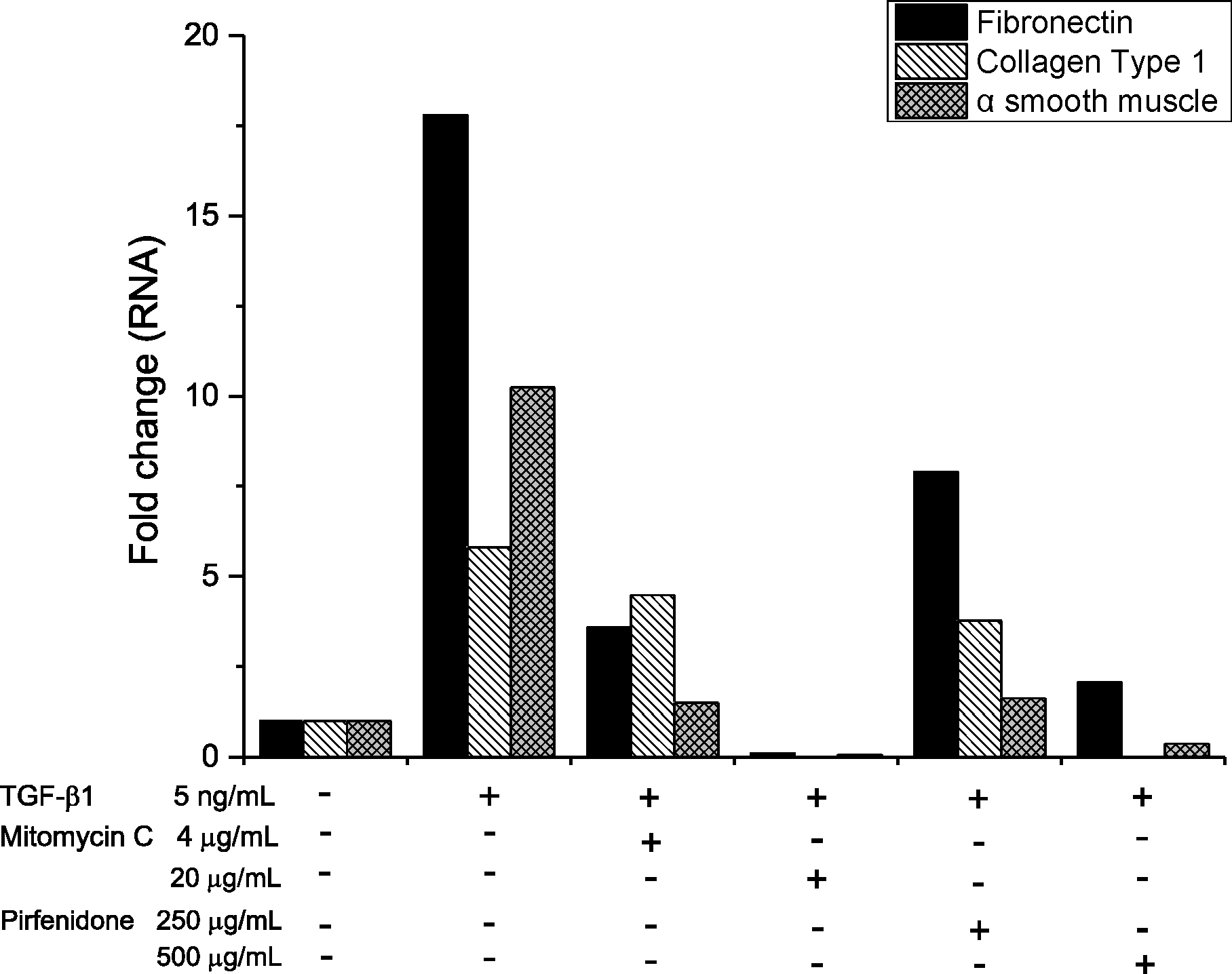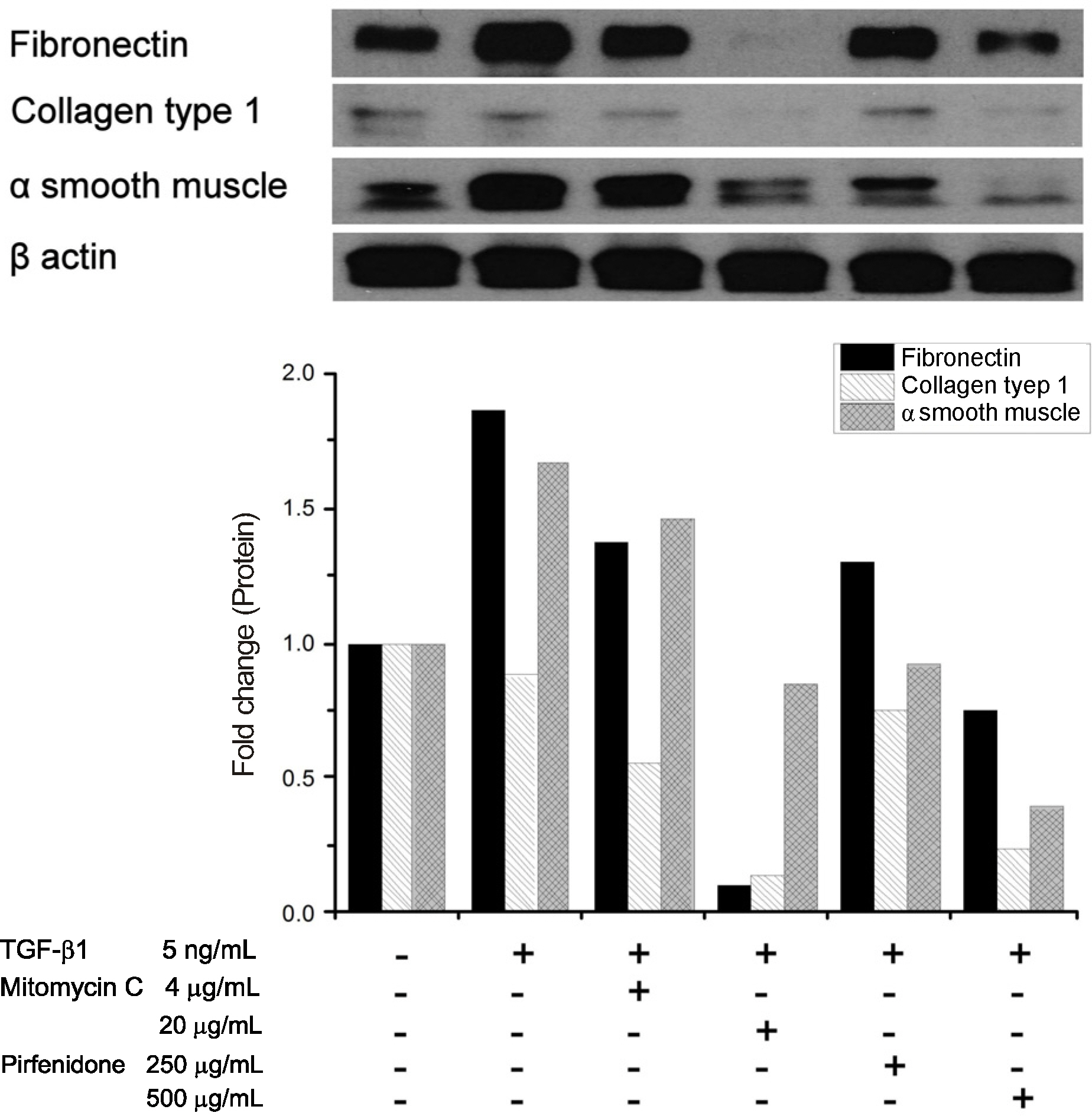J Korean Ophthalmol Soc.
2014 Jul;55(7):1077-1083.
Cytotoxicities and Anti-Fibrotic Effects of Pirfenidone and Mitomycin C on Human Fibroblasts
- Affiliations
-
- 1Department of Ophthalmology, Siloam Eye Hospital, Seoul, Korea.
- 2The Institute of Vision Research, Department of Ophthalmology, Yonsei University College of Medicine, Seoul, Korea. gjseong@yuhs.ac
Abstract
- PURPOSE
The cytotoxicities and anti-fibrotic effects of mitomycin C and pirfenidone on human dermal fibroblast were evaluated.
METHODS
Initially, 24-hour cell cultures were exposed to transforming growth factor (TGF)-beta1, different concentrations of mitomycin C, and pirfenidone solutions in order to evaluate cytotoxicity. Expressions of fibronectin, collagen type 1, alpha smooth muscle, and beta-actin were evaluated by real-time reverse transcription-polymerase chain reaction (RT-PCR) and western blot in mitomycin C solutions at concentrations of 4 microg/mL and 20 microg/mL, and in pirfenidone solutions at 250 microg/mL and 500 microg/mL.
RESULTS
In comparison to cell cultures exposed to TGF-beta1 solutions, cytotoxicities were increased in solutions of mitomycin C at 4 microg/mL, 20 microg/mL, 40 microg/mL and pirfenidone at 500 microg/mL, 750 microg/mL, 1,000 microg/mL (p < 0.05, Mann Whitney U-test). The results of real-time RT-PCR show that expressions of fibronectin, collagen type 1, and alpha smooth muscle were significantly more decreased in all concentrations of mitomycin C and pirfenidone compared to those in TGF-beta1 solution. In western blot analysis, expressions of fibronectin and alpha smooth muscle were decreased in all concentrations of mitomycin C and pirfenidone compared to TGF-beta1 solution.
CONCLUSIONS
Both drugs have cytotoxicities and anti-fibrotic effects, but pirfenidone was found to have less cytotoxicity and mitomycin C was found to have more anti-fibrotic effects when compared to each other.
Keyword
MeSH Terms
Figure
Reference
-
References
1. Carter NJ. Pirfenidone: in idiopathic pulmonary fibrosis. Drugs. 2011; 71:1721–32.2. Richeldi L, Yasothan U, Kirkpatrick P. Pirfenidone. Nat Rev Drug Discov. 2011; 10:489–90.
Article3. Iyer SN, Gurujeyalakshmi G, Giri SN. Effects of pirfenidone on transforming growth factor-beta gene expression at the transcriptional level in bleomycin hamster model of lung fibrosis. J Pharmacol Exp Ther. 1999; 291:367–73.4. Hewitson TD, Kelynack KJ, Tait MG, et al. Pirfenidone reduces in vitro rat renal fibroblast activation and mitogenesis. J Nephrol. 2001; 14:453–60.5. Gurujeyalakshmi G, Hollinger MA, Giri SN. Pirfenidone inhibits PDGF isoforms in bleomycin hamster model of lung fibrosis at the translational level. Am J Physiol. 1999; 276:L311–8.6. Oku H, Nakazato H, Horikawa T, et al. Pirfenidone suppresses tumor necrosis factor-alpha, enhances interleukin-10 and protects mice from endotoxic shock. Eur J Pharmacol. 2002; 446:167–76.7. Oku H, Shimizu T, Kawabata T, et al. Antifibrotic action of pirfenidone and prednisolone: different effects on pulmonary cytokines and growth factors in bleomycin-induced murine pulmonary fibrosis. Eur J Pharmacol. 2008; 590:400–8.
Article8. Iyer SN, Gurujeyalakshmi G, Giri SN. Effects of pirfenidone on procollagen gene expression at the transcriptional level in bleomycin hamster model of lung fibrosis. J Pharmacol Exp Ther. 1999; 289:211–8.9. Mitani Y, Sato K, Muramoto Y, et al. Superoxide scavenging activity of pirfenidone-iron complex. Biochem Biophys Res Commun. 2008; 372:19–23.
Article10. Di Sario A, Bendia E, Svegliati Baroni G, et al. Effect of pirfenidone on rat hepatic stellate cell proliferation and collagen production. J Hepatol. 2002; 37:584–91.
Article11. Yamazaki T, Yamashita N, Izumi Y, et al. The antifibrotic agent pirfenidone inhibits angiotensin II-induced cardiac hypertrophy in mice. Hypertens Res. 2012; 35:34–40.
Article12. Zhang S, Shiels IA, Ambler JS, Taylor SM. Pirfenidone reduces fibronectin synthesis by cultured human retinal pigment epithelial cells. Aust NZ J Ophthalmol. 1998; 26(Suppl 1):S74–6.
Article13. Lin X, Yu M, Wu K, et al. Effects of pirfenidone on proliferation, migration, and collagen contraction of human Tenon's fibroblasts in vitro. Invest Ophthalmol Vis Sci. 2009; 50:3763–70.
Article14. Kim H, Choi YH, Park SJ, et al. Antifibrotic effect of Pirfenidone on orbital fibroblasts of patients with thyroid-associated ophthalmopathy by decreasing TIMP-1 and collagen levels. Invest Ophthalmol Vis Sci. 2010; 51:3061–6.
Article15. Zhong H, Sun G, Lin X, et al. Evaluation of pirfenidone as a new postoperative antiscarring agent in experimental glaucoma surgery. Invest Ophthalmol Vis Sci. 2011; 52:3136–42.
Article16. Lama PJ, Fechtner RD. Antifibrotics and wound healing in glaucoma surgery. Surv Ophthalmol. 2003; 48:314–46.
Article17. Palanca-Capistrano AM, Hall J, Cantor LB, et al. Long-term out- comes of intraoperative 5-fluoro uracil versus intraoperative mito- mycin C in primary trabeculectomy surgery. Ophthalmology. 2009; 116:185–90.18. Franks WA, Hitchings RA. Complications of 5–fluorouracil after trabeculectomy. Eye (Lond). 1991; 5:385–9.
Article19. Seong GJ, Park C, Kim CY, et al. Mitomycin-C induces the apoptosis of human Tenon's capsule fibroblast by activation of c-Jun N-terminal kinase 1 and caspase-3 protease. Invest Ophthalmol Vis Sci. 2005; 46:3545–52.20. Chen T, Kunnavatana SS, Koch RJ. Effects of mitomycin-C on normal dermal fibroblasts. Laryngoscope. 2006; 116:514–7.
Article21. Anderson MT, Staal FJ, Gitler C, et al. Separation of oxidant-initiated and redox-regulated steps in the NF-kappa B signal transduction pathway. Proc Natl Acad Sci U S A. 1994; 91:11527–31.
Article22. Yao KS, O'Dwyer PJ. Involvement of NF-kappa B in the induction of NAD(P)H:quinone oxidoreductase (DT-diaphorase) by hypo-xia, oltipraz and mitomycin C. Biochem Pharmacol. 1995; 49:275–82.23. Baldassarre F, Mallardo M, Mezza E, et al. Regulation of NF-kappa B through the nuclear processing of p105 (NF-kappa B1) in Epstein-Barr virus-immortalized B cell lines. J Biol Chem. 1995; 270:31244–8.24. Stahnke T, Löbler M, Kastner C, et al. Different fibroblast subpopulations of the eye: a therapeutic target to prevent postoperative fibrosis in glaucoma therapy. Exp Eye Res. 2012; 100:88–97.
Article25. Shihab FS, Bennett WM, Yi H, Andoh TF. Effect of pirfenidone on apoptosis-regulatory genes in chronic cyclosporine nephrotoxicity. Transplantation. 2005; 79:419–26.
Article
- Full Text Links
- Actions
-
Cited
- CITED
-
- Close
- Share
- Similar articles
-
- Comparison of the Effects Between Bevacizumab and Mitomycin C on the Survival of Fibroblasts
- A Case Report of Pirfenidone-Induced Lichenoid Drug Eruption in a Patient with Idiopathic Pulmonary Fibrosis
- Effects of Valproic Acid on the Survival of Human Tennon's Capsule Fibroblasts
- Mitomycin C-induced apoptosis in cultured human Tenon's capsule fibroblasts
- Inhibitory Effects of Taxol and Mitomycin C on Proliferation of Cultured Rabbit Subconjunctival Fibroblasts




